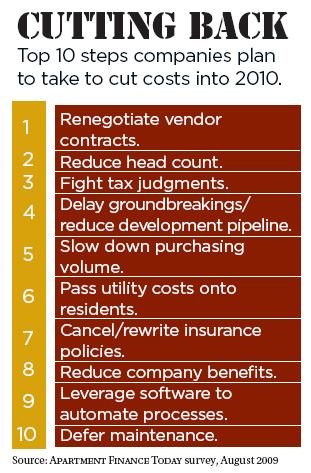The Bozzuto Group has also identified shadow pipeline possibilities—particularly as they involve land deals—that could conceivably begin next year. “We have three or four in the pipeline like that,” says the Greenbelt, Md.-based company’s CEO Tom Bozzuto. “I don’t think construction will start on them until 2011, but that’s still terrific because that has deliveries occurring in 2012 and 2013 when I think the economy will have rebounded and the demographic bubble will really be hitting the apartment business.”
3. Find Land Deals.
Integral to the Bozzuto development pipeline plan is the availability of buildable land, where current pricing is again keeping most players far from the market until sellers enter financial distress or otherwise come down from 2007 pricing. “I do think there are some selected opportunities out there where land sellers are recognizing that their land is not worth what they thought it was two and three years ago,” Bozzuto says. “If you can put together the proper deal structure, you could probably begin to work on construction.”
UDR, as well, is combing submarkets for entitled parcels, and CEO Toomey says his company will deploy dry powder for suitable deals in 2010 to get an edge on market competition and avoid bid-ups. “We don’t think a lot of people have the financial strength to buy in that area,” Toomey says. “As a result, you probably can get a better bargain.”
Still, others will stay the course and focus on acquisition opportunities until land prices reset, particularly in extreme high-barrier and high-cost markets. The dearth of construction lending, as well, has most on the sidelines in 2010 waiting for brighter days ahead. “Regardless of pricing, land today is worthless,” says New York-based Simon Development principal Matthew Baron. “There is simply no financing for it, and in 2010 through 2011, I can buy finished buildings for less than what it costs to build them. Why would I go through the headache of buying a piece of dirt, designing the building, and taking the construction risk when I can buy that building today?”
4. Rethink Your Product.
Green buildings could be a function of demographics as much as anything else in 2010 and the years to follow, and several developers are questioning status quo design at both the site and unit level as they consider groundbreaking possibilities in the next 12 months. “If you look at dormitories, fewer and fewer college kids live in shared space anymore,” Bozzuto says. “When those students become multifamily prospects, they aren’t going to want to share apartments. Perhaps we need to start building more one-bedroom apartments—maybe even more junior units.”
